#benin independence day
Text

Today is Independence Day in Benin, so we'd like to share a little piece of Beninese history with you!
The people is this photo are Agojie - often called Dahomey Amazons by Europeans.
The Agojie were regiments of soldiers who served in the army of Dahomey - now Benin - in West Africa in the 18th and 19th centuries. Numbering around 8000 at their height in the 1840, they were renowned for their fearlessness in battle, and considered the backbone of the Dahomean army.
The Agojie were all assigned female at birth but they expressed their gender in a variety of ways. Some renounced womanhood, and identified themselves as men. At other times, the group embraced womanhood in their war songs, comparing themselves to lionesses, and linking womanhood to their superiority over male regiments.
Learn more
[Image: photo of a group of Agojie, some pose with weapons including guns and large knives]
#benin#beninese history#queer history#agojie#african history#black history#lgbt history#lgbtq#queer#benin independence day
207 notes
·
View notes
Text
Benin Independence Day Messages and Wishes

Celebrate this day by sharing with your family and friends inspiring quotes and sayings on Benin Independence Day. Wish everyone with the best Benin Independence Day wishes and greetings.This post includes the newest collection of Happy Benin Independence Day messages, quotes, greetings and status to share on Facebook, Instagram and WhatsApp with everyone.
0 notes
Text

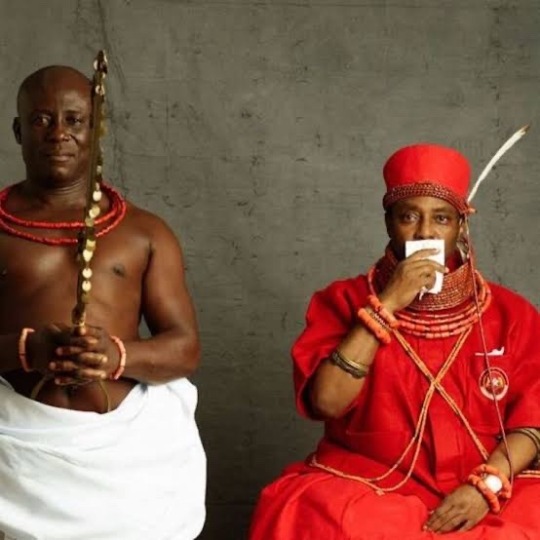
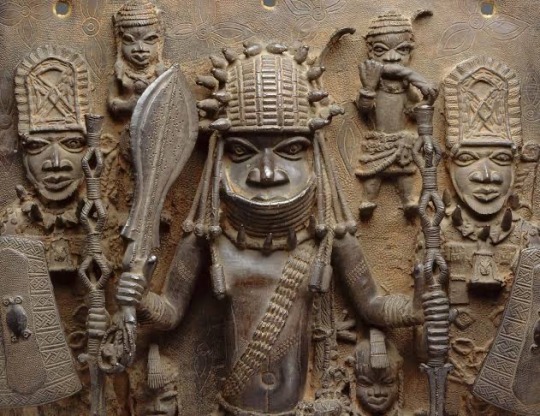
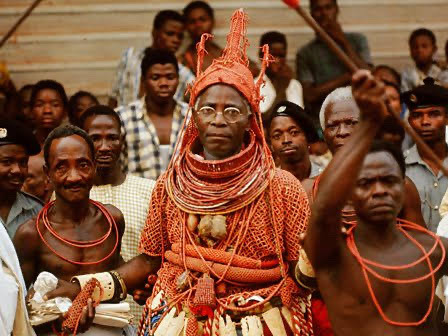
Black history is not slavery
Slavery is not the only history of black Black history goes deeper than slave trade
This is a message for my black brothers and sisters
Today I will be talking about the people of benin
The historical kingdom of Benin was established in the forested region of West Africa in the 1200s C.E. According to history, the Edo people of southern Nigeria founded Benin. They no longer wanted to be ruled by their kings, known as the ogisos. They asked a prince from Ife, an important West African kingdom, to take control. The first oba, or king, in Benin was Eweka. He was the son of the prince from Ife.The kingdom reached its greatest power and size under Oba Ewuare the Great. He expanded the kingdom and improved the capital, present-day Benin City; the city was defined by massive walls. The height of power for Benin’s monarchs began during this period. To honor the powerful obas, the people of Benin participated in many rituals that expressed their devotion and loyalty, including human sacrifices.Artists of the Benin Kingdom were well known for working in many materials, particularly brass, wood, and ivory. They were famous for their bas-relief sculptures, particularly plaques, and life-size head sculptures. The plaques typically portrayed historical events, and the heads were often naturalistic and life size. Artisans also carved many different ivory objects, including masks and, for their European trade partners, salt cellars.The success of Benin was fueled by its lively trade. Tradesmen and artisans from Benin developed relationships with the Portuguese, who sought after the kingdom’s artwork, gold, ivory, and pepper. In the early modern era, Benin was also heavily involved in the West African slave trade. They would capture men, women, and children from rival peoples and sell them into slavery to European and American buyers. This trade provided a significant source of wealth for the kingdom.Benin began to lose power during the 1800s, as royal family members fought for power and control of the throne. Civil wars broke out, dealing a significant blow to both Benin’s administration as well as its economy. In its weakened state, Benin struggled to resist foreign interference in its trading network, particularly by the British. A desire for control over West African trade and territory ultimately led to a British invasion of Benin in 1897. Benin City was burned by the British, who then made the kingdom part of British Nigeria (which became Nigeria after the country gained independence in 1960). After that time, the kingdom no longer played a governing role in West Africa. However, even today, the oba still serves in Benin City as a government advisor.


#life#culture#black history#history#blm blacklivesmatter#aesthetic#generations from exile tribe#genshin fanart#sculpture#nigeria#heritage#transgender#traditional media
717 notes
·
View notes
Text
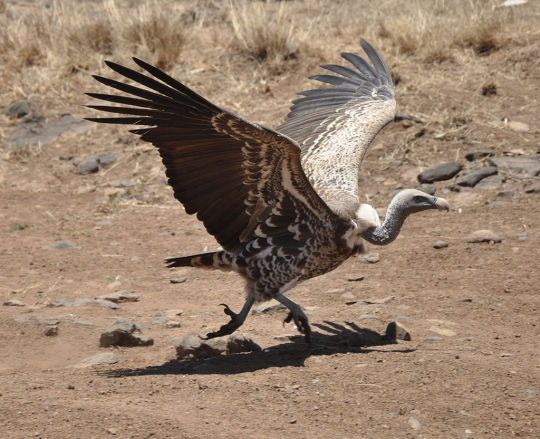
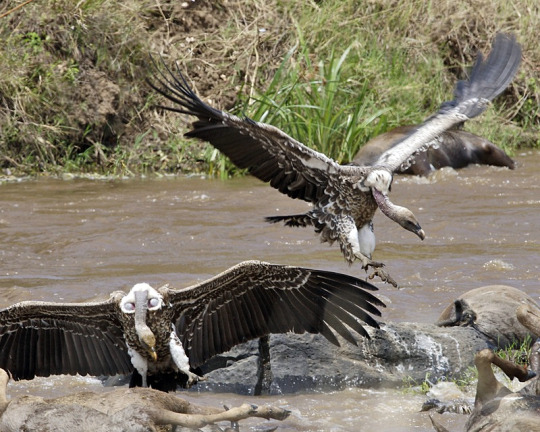
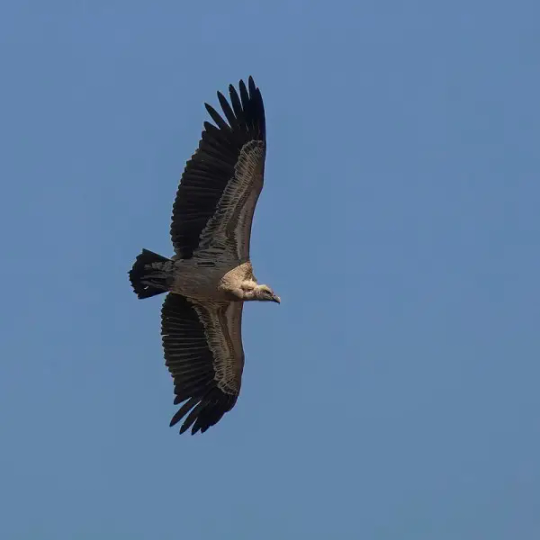
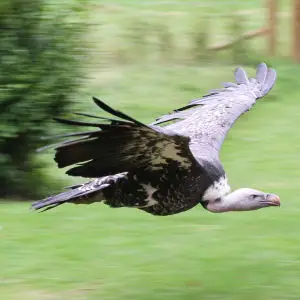

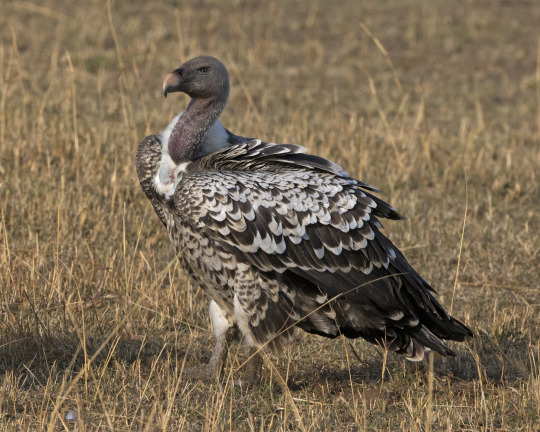
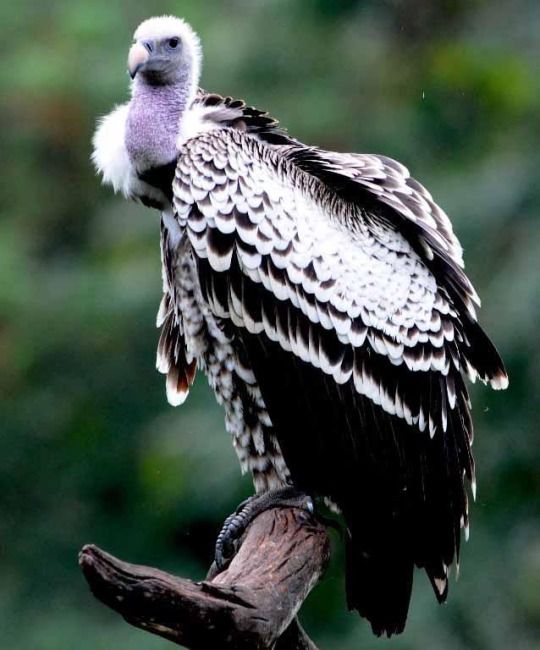
Rüppell's vulture also called Rüppell's griffon vulture, named after Eduard Rüppell, is a large bird of prey in the genus Gyps which is native throughout the sahel and eastern Africa including the countries of Algeria, Benin, Burkina Faso, Burundi, Cameroon, the Central African Republic, Chad, The Ivory Coast, Djibouti, Eritrea, Ethiopia, Gambia, Ghana, Guinea, Guinea-Bissau, Kenya, Mali, Mauritania, Niger, Nigeria, Rwanda, Senegal, Somalia, South Sudan, Sudan, Tanzania, Togo, and Uganda. Here they tend to inhabit grasslands, mountains, and open woodland. Rüppell's vultures are diurnal and very social birds, roosting, nesting, and feeding in large flocks. They spend much of their time flying at great altitudes, using strong winds and thermals to efficiently soar they are known to regular cruise at upwards of 20,000ft (6,000m) above the ground with some known to go as high as 37,000ft (11,300m) making them the highest flying bird. These vultures locate food by sight only, and often follow herds of animals. Once they find a carcass they swoop down, land a little way off, then bound forward with wings spread and their long neck outstretched. Even amongst old world vultures, Rüppell's vultures are specialized feeders with a spiked tongue and strong beak they can strip flesh with ease, and feed upon pelts, hides, and even the bones themselves. Reaching around 33 to 41in (85 -103cms) long, 14 – 20lbs in weight, with a 7.5-8.6ft (2.26 -2.6m) wingspan. They are one of the largest vultures in Africa, both sexes sport mottled brown or black feathering overall with a whitish-brown underbelly and thin, dirty-white fluff covering the head and neck. The base of the neck has a white collar, the eye is yellow or amber, the crop patch deep brown. The head does not have feathers. This species of vulture is considered to be monogamous, forming lifelong breeding pairs. They nest on cliffs in colonies up to a 1,000 strong. After courtship a pair will work together to build a nest using sticks, grass, and leaves that they have gathered or stolen from other nests, here the mother will lay 1 egg. Both parents share in incubation of their egg over a period of 55 days. Once the chick hatches, both parents will feed and tend to it for about 150 days when it fledges. Young remain dependent on their parents after fledging, not reaching independence until the next breeding season. Under ideal conditions a ruppells vulture may live up to 50 years.
#pleistocene#pleistocene pride#pliestocene pride#pliestocene#bird#dinosaur#vulture#ruppells vulture#africa#asia#europe#eurasia#flying#griffon#griffin#griffon vulture
436 notes
·
View notes
Text
Cheetah
AKA: spotted one (indian original name)
Acinonyx jubatus
Felidae family, acinonyx genus

Ultimate Infodump Sheet
General description
Cheetahs have pale yellow, grayish or fawn coats, covered in tiny black spots. The belly fur is lighter than the rest, while the color tends to darken on the back. Cheetahs have distinctive markins under the eyes that go down the muzzle, called a tear mask. They have black rings around the last third of the tail.
The cheetah's paws are long and narrow. They have semi-retractile claws on the front paws, and non-retractile claws on the hind paws.
Cheetahs' head-body length ranges from 112 to 150 cm (44 to 59"), and they are 67 to 94 cm (26 to 37") tall at the shoulder. Cheetahs weight between 21 and 72 kg (46 to 158 lbs). Males are usually larger than females.
They live 6 years on average in the wild, and 19 in captivity.


King cheetahs
The patterns of a king cheetah are caused by a slight melanism. Overall, the spots are bolder, sometimes even forming stripes. They have large stripes along the entierty of thair back, and rings are present on most of the tail.

Physical aptitudes
Cheetahs are the fastest land animal. The highest speed recorded for a cheetah was 113 km/h (70 mi/h). They are the only big cat able to turn in the air while sprinting. They use their tail for steering while they are running. They are bad tree climbers.
Contrary to members of the panthera genus, they do not roar: instead, cheetahs can purr, meow, chirp and yeep.
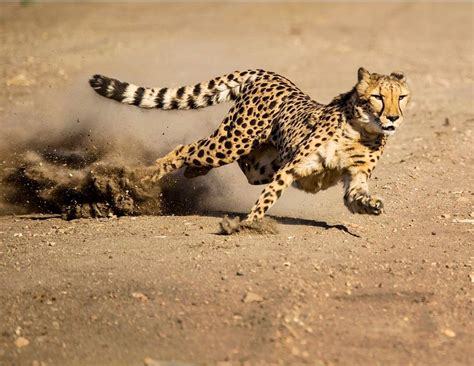
Habitat
Cheetahs live in savanna, shrublands, grasslands, wetalands, rocky areas, and in the desert. Due to their light weight, they are capable of living in dunes.
Cheetahs present in several small areas of Africa, in countries such as Algeria, Angola, Benin, Ethiopia, Tanzania, Uganda... They are extint on an alarmingly large portion of Africa.


Diet
Cheetahs are carnivorous. Their diet includes gazelles (especially the Thompson's gazelle), impalas, as well as other small ungulates. They also prey on hares, birds, and other small animals.
Cheetahs charge from 70 to 100 meters (27 to 40 feet) away from the prey. They strangle the animal with their jaws. The chase can only last 500 meters (196 feet), and cheetahs can only maintain their top velocity for a few hundred meters.
Contrary to most felids, cheetahs are diurnal and hunt primarily during the day.

Reproduction
Cheetahs reproduce year-long, but mostly during wet season. Makes provide no parental care, and only interact with females during mating. If the female encounters a coalition, she will most likely reproduce with several males.
Gestation lasts between 90 and 95 days (about 3 months). Cubs open their eyes 4 to 11 days after birth, and start walking after 12 days. The litter size in the wild is 1 to 6 cubs, with an average of 3. In captivity, litters with 8 cubs have been recorded. Cubs are weaned between 3 and 6 months, and become independent between 15 and 17 months.
Cheetah cubs have a long, blue-ish gray mane along their head, neck and back, called "mantle". They gradually lose this fur until they reach adolescence. A study suggests that the mantle makes cubs ressemble honey badgers, which aids them to survive as a lot of animals avoid honey badgers.
Predation is the highest on cheetah cubs. The survival rate in Serengeti National Park, where several large carnivores live, is of only 17%.

Endangered
Cheetahs are classified as vulnerable in the IUCN Redlist. The population is fragmented and keeps on decreasing.
The causes are all human: climate change, energy production and mining, urban development, agriculture, roads, hunting, human intrusion, modification of natural systems, invasive species....

Extra links
An interesting, well illustrated informational website that I wish I'd found earlier in writing this
Amazing footage of a cheetah hunting a wildebeest
SOURCES
6 notes
·
View notes
Text
On Haiti's day of ancestral remembrance, one of my siblings shared this letter with us. It is a monumental letter; it has not been often that Africa has collectively spoken to and about Haiti. It's a sad and beautiful love letter, and speaks some really deep truths. They are right; Haiti is dying right now and it is past time that the international community take responsibility for what hundreds of years of international interference has wrought. I hope this is the impetus for action because the reality of Haiti right now is worse than can accurately be described.
Below is an English translation of the above linked article.
EMBARGO: January 1 , 2023
And especially my body as well as my soul,
be careful not to cross your arms
in the sterile attitude of the spectator,
because life is not a spectacle,
because a sea of pains is not a proscenium,
because a a screaming man is not a dancing bear.
Aimé Césaire, Excerpt from Notebook of a Return to the Native Land (1939).
Captured in the valleys once trodden by Afarensis, or from Zanzibar, Madagascar, Gorée, El Mina, Bimbia, Benguela, Luanda, Cabinda, savannahs and forests, Ségou, Benin, Sokoto, the banks of the Congo or Oubangui, or along other great rivers, Ogooué, Casamance, Niger, Sanaga, having left the cosmogony that still binds them today to the mother of all continents, enslaved Africans arrived centuries ago in the Americas . In the worst forced migration of all time, the transatlantic slave trade took some of these men, women and children to Kiskeya, also known as Hispaniola, the island now shared by Haiti and the Republic Dominican Republic in the Caribbean Sea.
A land immersed in African traditions, Haiti, the "Pearl of the Antilles" or "Mountain Country" in the Taino language, is the nation where black slaves have shown the greatest resilience.
On August 14, 1791 in the forest of Bois Caïman, the voodoo priest Dutty Boukman organized a ceremony with the support of the priestess Cécile Fatiman, a "mambo" who performed sacrifices. On that memorable stormy night, the enslaved participants solemnly swore that servitude would be doomed, taking an oath to fight or die. They will later obey the orders of Toussaint Louverture in the revolt orchestrated by the remarkable leader. His epic – rare, if not unique – victory over one of the worst crimes ever committed against humanity continues to be recounted by many. Toussaint, a Caribbean island strategist and visionary, defeated the stubborn Napoleon, an island native from Corsica. This historic victory has been sung by great poets like Aimé Césaire.
On January 1, 2023, the first black republic celebrates the 219th anniversary of its glorious independence. However, the Pearl of the Antilles is dying.
Haiti was forced to pay a ransom to France as compensation to French slave owners for lost property, or else slavery would be reimposed and Haiti invaded. In May 2022, The New York Times published a well-researched series of articles titled “The Ransom: Haiti Lost Billions” [ The Ransom: Haiti Lost Billions], which recounts this perfidy. Port-au-Prince has so far paid up to $115 billion to France, a staggering sum for Haiti, a ransom that has left the poor country heavily indebted. Poor governance, corruption and invasions add to an already unbearable burden for the Haitian people. In addition, the American military occupation, from 1915 to 1934, had a large New York bank as its main financial backer. Ultimately, all of these factors could only result in a failed state fueled for many decades by the adrenaline of violence and the jolts of anarchy and chaos. The ravages of earthquakes, massive deforestation and the exile of its citizens have worsened the plight of Haiti.
Tormented and neglected, installed in instability, Haiti seems close to shipwreck. The security situation is dire. Famine affects nearly five million people. Shortly after the 2010 earthquake, a cholera epidemic imported by UN peacekeepers broke out in Haiti after no case had been detected there for more than a century. In the face of these accusations, the then United Nations Secretary-General, Ban Ki-moon, had the courage and integrity to issue a formal apology. Today, the resurgence of cholera is causing more deaths. On December 21, 2022, addressing the Security Council, United Nations Deputy Secretary-General Amina J. Mohammed said that “Haiti finds itself in a deepening crisis of a magnitude and unprecedented complexity."
One of the biggest challenges is that much of Port-au-Prince – a capital of nearly 3 million people – is in the hands of gangs. Their names are taken from urban tragedies – 400 Mawazos , Chen mechan , Fire-eaters… . The list of gang leaders includes Barbecue, Gaspiyai… . Their only motivation seems to be financial and criminal. The gangs have taken the country hostage: they kill; they rape; they are flying. Sexual violence is the breeding ground for a future in which society may lack cohesion.
The police are either overwhelmed or complicit. The Haitian army, that not-so-distant Macoute memory, was dismantled by the international community in the 1990s. Demobilized soldiers were never properly reintegrated into society. The judicial system is moribund. To date, the international community has been able to fund less than 20% of Haiti's current humanitarian needs, while elsewhere in the world billions of dollars are generously flowing in to alleviate other humanitarian crises.
Haiti, the poorest country in the Western Hemisphere is caught in a recurring nightmare, as if the country relives the adventures told in " The Comedians ", a masterpiece published by Graham Greene in 1966. The novel, located under the reign of François "Papa Doc" Duvalier and his Tontons Macoutes, explores the political repression and terrorism that are rampant in Haiti, and particularly in Port-au-Prince.
However, Haiti should not be viewed solely as a tragic and brutal story. The country of Makandal, Toussaint and Dessalines is endowed with magnificent creativity and sustained by remarkable hope. Haiti has always been culturally brilliant and intellectually stimulating.
The iconic Hotel Oloffson in Port-au-Prince once attracted bands such as the Rolling Stones. Afterwards, hellish processions of the Ra-Ra by the "root music" group RAM invaded the hotel. Haiti is also the country of the talented musician Wycleff Jean; the Tabou Combo group; or even the unforgettable Jean Gesner Henry, alias Coupé Cloué or “the African”, the king of kompa mamba, a catchy musical style widespread throughout the world. Writers, playwrights, filmmakers, poets, artists, educators, musicians and artisans abound. The stunning beauty of the countryside is praised in the books of Haitian neurologist, novelist and poet Jean Métellus (1937 – 2014), such as in Jacmel at Dusk. Christophe, tragic king, is immortalized in a masterpiece by Aimé Césaire, the literary giant of neighboring Martinique. For more than a century, Haiti has also given birth to magnificent authors and poets: Joseph Anténor Firmin, Louis Joseph Janvier, Justin Lhérisson, Jean-Price Mars, Félix Morisseau-Leroy, Charles Moravia, Frankétienne, Anthony Phelps, Dany Laferrière , Louis-Philippe Dalembert, Edwige Danticat, René Depestre… and many others.
The biggest tragedies, like the 2010 earthquake, certainly killed and maimed many people, destroying infrastructure. But these dramas have not shaken the soul of this astonishing and endearing country. Like the intrepid Haitian woman, Haiti remains surprisingly upright, and its culture vibrant.
The international community, sub-regional and regional organizations, academics, media, communicators, the private sector, the Haitian comprador bourgeoisie: all have a responsibility towards Haiti. It's not an easy conversation. Migration issues are a hot topic in most Western countries. In September 2021, images of American guards on horseback armed with whips pushing back Haitian migrants at the border with Mexico caused a stir around the world. But these whiplashes from the time of the slave trade cannot rewrite the heroic history that Haitians wrote with their blood, sweat, tears and courage. Haiti is the only slave-led military uprising that was able to overthrow a slave-holding colonial power.
The international community was called upon to step in and fight the gangs. Just as the corrugated iron walls of Haiti's slums will not stop stray bullets, our physical estrangement from Haiti will not prevent tragedy from piercing our souls and our comfort zones. In light of past failures, one can honestly wonder if foreign military intervention in Haiti would provide a lasting solution. Either way, inertia is not an option. Any intervention must revisit history and learn from it, prioritize security, actively promote and support justice while helping to build trust and good governance. The situation must be addressed as a whole, without delay.
What the international community will or will not do is of crucial importance. Nevertheless, we support Haitian citizens who want an end to anarchy and violence, who want justice. To measure the strength and value of a family, one must observe the solidarity with which it protects the most vulnerable of its members. The first black republic, perhaps the most fragile of the family of Nations, lacks food, drinking water, fuel, peace, justice.
We issue this urgent call: let us act now, with a new and genuine benevolence, whatever the risks, and without individual geopolitical intentions. Haitian populations are in danger. History will not be kind to those who remain inactive or who choose to look elsewhere.
It would be non-assistance to a people in danger.
It is difficult to envisage the resolution of this Gordian knot without outside intervention. The Haitian people will only be able to vote and freely choose their leaders if there is security.
A member of the family of nations is held hostage by the contours of historic injustices, recurring bad governance and the brutality of armed gangs: the whole family must step in to free this member from the hostage takers as well as the contingencies of previous failures. Haitians would fly with with their wings towards the heights of human development, we sincerely hope so.
Sitting idly by is not an option.
So let's gather our forces for success in Haiti, and as Césaire predicted, there will be room for everyone at the rendezvous of victory .
Otherwise, we will all be guilty of not having helped this heroic people in danger.
Let us respond to the poetic exhortation of Jean Métellus. From his exile a few decades ago, his poem was a beautiful cry, “ Au pipirite chantant ”. His lament has not aged a bit. This is the plea of
“Haitian peasant who with singing pipirite,
despises memory and makes plans
He revokes the past braided by plagues and smoke
And from daybreak he tells his glory on the fresh galleries
of young shoots”
We stand with the Haitians. Let's act now. For Haiti, for humanity.
(*) Signatories:
Adama Dieng , the initiator of this forum, is a former United Nations Under-Secretary-General. He served in the UN as a former Special Adviser for the Prevention of Genocide and Registrar of the International Criminal Tribunal for Rwanda. He is also a former board member of the International Institute for Democracy and Electoral Assistance (IDEA).
Macky Sall , President of Senegal, President of the African Union.
José Ramos-Horta , President of the Democratic Republic of Timor-Leste; co-recipient of the Nobel Peace Prize in 1996.
Moussa Faki Mahamat , Chairperson of the African Union Commission; Former Prime Minister of Chad.
Alpha Oumar Konaré , former President of Mali; former Chairperson of the African Union Commission; former President of the Economic Community of West African States (ECOWAS).
Goodluck Ebele Azikiwe Jonathan , former President of Nigeria; Mediator of the Economic Community of West African States (ECOWAS).
Catherine Samba-Panza, former Head of State, Central African Republic.
The Right Honorable Michaëlle Jean , former Governor General of Canada; former UNESCO special envoy to support reconstruction efforts in Haiti; former Chancellor of the University of Ottawa; former Secretary General of the International Organization of La Francophonie (OIF).
Phumzile Mlambo-Ngcuka , former Vice-President of South Africa; former Executive Director of UN Women; Former Co-Chair of the United Nations Descendant Senior Officials Group (UNSAG).
Epsy Alejandra Campbell Barr , former Vice President of Costa Rica; President of the Permanent Forum for People of African Descent.
Graça Machel , President of the Board of the Graça Machel Foundation ( Graça Machel Trust ).
Miguel Ángel Moratinos , former High Representative of the United Nations Alliance of Civilizations; former Chairman-in-Office of the OSCE; former Spanish Minister for Foreign Affairs and Cooperation.
Sir Dennis Byron , former President of the Caribbean Court of Justice; former President of the Commonwealth Judicial Education Institute ; former President of the International Criminal Tribunal for Rwanda (ICTR); Chairman of the United Nations Internal Justice Council.
Serge Letchimy, President of the Executive Council of Martinique and former member of the French National Assembly.
Mujahid Alam (Retired General), Principal of Lawrence College , Ghora Gali, Murree, Pakistan.
Sonia Maria Barbosa Dias , Education Specialist, São Paulo, Brazil.
Mbaranga Gasarabwe , former Deputy Special Representative of the United Nations Multidimensional Integrated Stabilization Mission in Mali (MINUSMA); former United Nations Resident Coordinator in Mali; former United Nations Under-Secretary-General for Safety and Security.
Souleymane Bachir Diagne , Philosopher; Director of the Institute of African Studies and Professor of French and Philosophy at Columbia University.
Andrew Thompson , Professor of World Imperial History at Oxford University and Full Professor at Nuffield College , Oxford.
Othman Mohamed , former Chief Justice of Tanzania and Chairman of the Commission of Inquiry into the death of Dag Hammarskjöld.
Amadou Lamine Sall , Winner of the 2018 edition of the Tchicaya U Tam'si Prize for African Poetry; Winner in 1991 of the Prize for the influence of French language and literature, awarded by the French Academy.
Sheila Walker, Ph.D. , Author; Cultural anthropologist and documentary filmmaker; Executive Director of Afrodiaspora, Inc.
Jean-Victor Nkolo , former spokesperson for three Presidents of the United Nations General Assembly; Worked in ten UN peacekeeping operations, including in Haiti.
Euzhan Palcy , Director, screenwriter and film producer (Martinique, France).
Bacre Waly Ndiaye , Lawyer at the Bar of Senegal; Former member of the Truth and Justice Commission in Haiti.
Willem Alves Dias , Film Editor, Brazil.
René Lake, Journalist and Expert in international development.
Doudou Diène, Senegalese lawyer; former UN Special Rapporteur on contemporary forms of racism, racial discrimination, xenophobia and related intolerance.
Ben Kioko , Judge, former Vice-President of the African Court on Human and Peoples' Rights.
Aver-Dieng Ndaté , Lawyer at the Geneva Bar, Vice-President of the African Peace Conference.
Akere Tabeng Muna , Lawyer and International Legal Consultant on Governance and Anti-Corruption; former President of the Pan-African Lawyers Union; former President of the Economic, Social and Cultural Council of the African Union (ECOSOCC); former Chair of the Panel of Eminent Persons of the African Peer Review Mechanism (APRM).
Carol Christine Hilaria Pounder-Kone , aka CCH Pounder , Actress and philanthropist; Art collector; HIV/AIDS activist; co-founder of the Boribana museum in Dakar.
19 notes
·
View notes
Text
Independent Reviews 5 - The British Museum
As a history and art nerd, the British Museum was mandatory to visit. The British Museum is probably one of the largest collections of historic artifacts and art in the world. And the museum is infamous among anyone with a smattering of anti-colonial sympathies as an egregious collection of imperial loot. That’s what I knew going in.
But there was a thought I had. I’ve heard a lot that “there’s nothing British in the British Museum”. While obviously hyperbolic, I wanted to see just how much of the collection is genuinely from Britain, or at least Western/Northern Europe.
What I found was that there is an almost overwhelming amount of artifacts on display from Britain alone, let alone the sheer amount from Western Europe at large. I spent a good 2 hours just cruising the collections of the Ancient European, Roman Britain, Anglo-Saxon and Early Middle Ages, Medieval, Renaissance, and Early Modern exhibits. Not even taking the time to really read and just look at the artifacts. If I wanted to do that, I’d need a whole day and probably another one too if I wanted to study the artifacts.







I took pictures of some of the collections, these are all ones from England, Britain, or Western Europe, all crowded together like this.
There was so much there that was British, English, or at least Western European. So much and it was crowded into a handful of rooms. How much better could I appreciate these artifacts if they gave back the stolen heritage here, and spread their artifacts out across the space instead? I saw the Sutton Hoo Helmet, the Battersea Shield, the Waterloo Helmet, I saw clasps and glass over a thousand years old. Beautiful crafts from England’s people going back millenia. Why isn’t that enough?


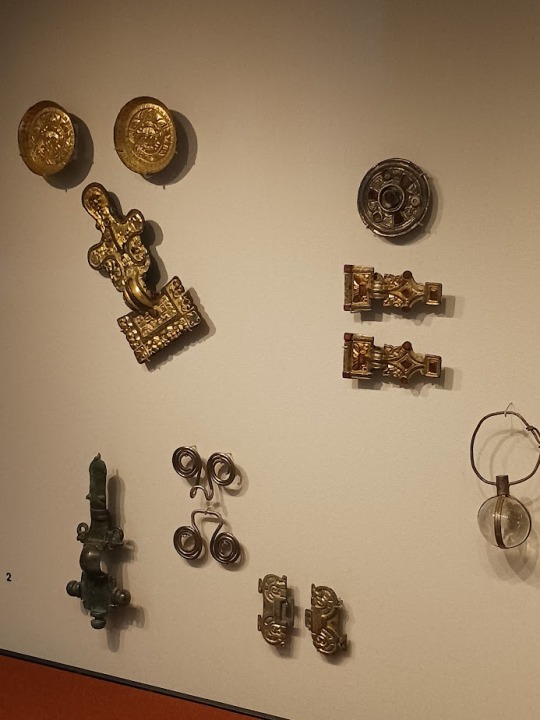

Anglo-Saxon artifacts, including the famous Sutton Hoo Helmet.
Something I’ve read a few times is that Britain and England especially is embarrassed by their history and culture, but it’s embarrassment isn’t the empire or the suffering, but the parts of their story they should cherish the most. Their folktales, their customs and quirks, their ancient artifacts, and their myths.
The British museum has said they can’t give back things like the Elgin Marbles or the Benin Bronzes or the Rosetta Stone because then their museum would be empty. But what I saw from Britain would take ages to truly appreciate. So is that what they think of Britain’s history? Of England’s millenia old history? That it’s nothing?
#genuinely i feel both sad for them and angry at the same time#YOU DARE HOARD OTHER PEOPLE'S HERITAGE AND HISTORY OVER AN INFERIORITY COMPLEX#its maddening#british museum#one thing i thought was intersting about England was how despite the English as a culture only dating back to the roughly 7th century#their history as a nation and a land is so much older#british empire#british history#england
2 notes
·
View notes
Text
7 years later, let's remember the horror
By Mathis Alloul
7 years ago, on 13 November 2015, France experienced one of its darkest days. In strategic locations in Paris, several Islamic State terrorists used their weapons to kill as many people as possible. Like every November 13 since that disaster, it is time to remember and pay tribute, and this article will do just that.

Montage de plusieurs images représentant les attentats du 13 novembre 2015. Auteurs des photos: Eric salard, Chris 93, maya-Anaïs Yataghène, Mstyslav Chernov.
Let us recall the facts
On 13 November 2015, France experienced the deadliest attacks in its history on its soil. A commando of about ten terrorists divided into small groups formed for the attack, all led by the terrorist Abdelhamid Abaaoud. The attacks are organised by the Islamic State (EI) organisation in Syria.
6 different attacks will take place:
-The first attack took place near the Stade de France. Four people were killed, including three terrorists who blew themselves up. The explosions were intended to take place inside the stadium, the aim being to kill as many people as possible during the France-Germany football match.
-The second attack killed 13 people in the restaurants Le Carillon and Le Petit Cambodge in the 10th arrondissement.
-The next attack took place at the Café Bonne Bière brasserie and the Casa Nostra restaurant, killing 5 people.
-The largest attack took place at the Bataclan where 90 people (including 3 terrorists) died while attending a concert.
-The fifth attack took place in a bar in the 11th arrondissement, La Belle Équipe, where 21 people died.
-Finally, a fifth attack took place in the 11th arrondissement at the restaurant Comptoir Voltaire, which can be considered a failure because the only dead person was a terrorist.
Another attack was planned by the OEI on 13 November 2015 and targeted Amsterdam airport, which fortunately failed. A state of emergency will be declared following these attacks, a first since the Algiers coup in 1958.
After the terror comes the mourning, President François Hollande decrees 3 days of national mourning. Benin and Hungary will also impose a day of national mourning in support of France. The European Union is calling for a minute's silence for all Europeans. Many historic places will fly the French flag around the world, such as the Sydney Opera House or the Mexican Independence Monument in Mexico City.
Tributes have been paid on this 13 November 2022
These tributes will take place 5 months after the trial of the terrorist Salah Abdeslam, the only member of the commando still alive. Other people have been tried for having participated in the organization of the attack. A new tribute to the victims, seven years later. Commemorative ceremonies are taking place on Sunday 13 November in Paris and Saint-Denis, in honor of the victims of the attacks of 13 November 2015.
The Prime Minister, Elisabeth Borne, is taking part in these commemorations along with the Mayor of Paris, Anne Hidalgo, which began in Saint-Denis at 9am. "This ceremony, placed under the sign of sobriety, dignity and recollection, will take place without speeches. During its match against Auxerre, the Paris Saint-Germain football club will wear a badge in tribute to the victims. The film "November" released a month ago can also be seen as a tribute, particularly to the work of the intelligence services in finding and neutralising the remaining terrorists.

Place de la République le 13 novembre 2015
7 notes
·
View notes
Text
Angélique Kidjo, Bill T. Jones & Thelonius Monk Documentaries Are Scheduled For Season 15 Of AfroPoP: The Ultimate Cultural Exchange
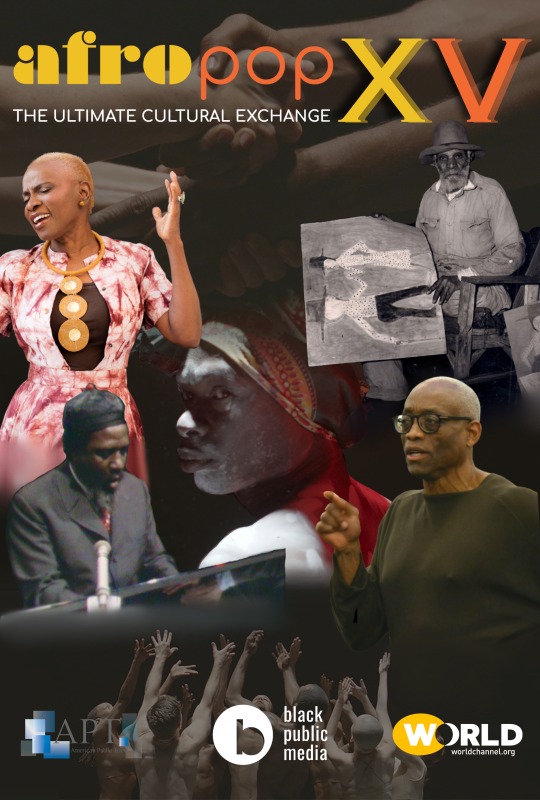
Documentaries about African singer Angélique Kidjo, choreographer Bill T. Jones and jazz musician Thelonious Monk are scheduled for season 15 of AfroPoP: The Ultimate Cultural Exchange. The new season is different from previous ones because it focuses on one theme by singling out Black art for the first time. The WORLD Channel has been the home and co-producer of the show with Black Public Media since 2010. Leslie Fields-Cruz, BPM executive director and AfroPoP executive producer had this to say about their 15th anniversary:
“When we created AfroPoP: The Ultimate Cultural Exchange it was our hope that we would be able to bring stories of modern Black life to public media audiences and help augment viewers’ ideas of what Black life is and can be,” said Leslie Fields-Cruz, BPM executive director and AfroPoP executive producer. “Witnessing the series reach its 15th season, a landmark that is the result of the work and drive of so many people over the years, is an awe-inspiring and humbling moment that fills me with great gratitude.”
The premiere of Can You Bring It: Bill T. Jones and D-Man In The Waters will stream exclusively on Black Public Media's YouTube Channel at midnight ET on Monday, April 3rd. The film will screen later on that day at 8 PM ET on WORLD Channel. The feature looks at the ballet D-Man In The Waters originally presented in 1989 by Jones and his late partner Arnie Zane. The ballet was created in response to the A.I.D.S. crisis at the time and its impact on their dance company and friends.
Claire Duguet's Queen Kidjo will screen on April 10th. The film follows Kidjo's beginnings in Benin and her rise to legendary status. Bill Traylor: Chasing Ghosts is a portrait of the painter Bill Traylor who was born a slave and started painting scenes of his life on a plantation and the changing urban world at age 85. Jeffrey Wolf's film about Traylor is scheduled for April 17th. The Sound Of Masks is about a Mapiko dancer from Mozambique. The Mapiko dance is exclusively performed by male members of the Makonde community as a tool of independence to defy the colonizing influence of the Mozambican War Of Independence. Sara CF de Gouveia's feature about Mapiko is scheduled to be seen on April 24th. Rewind & Play is Alain Gomis's exhibit of the disrespect jazz pianist and composer Thelonius Monk experienced in 1969 during an appearance on French state television. Rewind & Play will air on May 1st. AfroPoP has been presenting
AfroPoP: The Ultimate Cultural Exchangecan also be viewed on WORLD Channel’s YouTube channel and on all station-branded PBS platforms, including PBS.org and the PBS Video app. The program is available on iOS, Android, Roku streaming devices, Apple TV, Android TV, Amazon Fire TV, Samsung Smart TV, Chromecast and VIZIO. APT will release the season to public television stations across the country on Monday, May 1. For viewing information, check local listings.
youtube
youtube
youtube
youtube
youtube
#afropop: the ultimate cultural exchange#bill traylor#angelique kidjo#thelonius monk#black public media#mapiko#Youtube
2 notes
·
View notes
Note
Got a list of books on Port for any of us anon's who enjoy physical books to order online or from a bookstore?
Oh, man, I do most of my research online these days :(
But I'll point you to some tips that might help you!
What you can do is go to a bookstore and see what they have. They'll probably have a broad, mostly washed up, version of Portuguese history, but that will serve as your base and you can build on top of that.
It's important to get multiple sides and what's wonderful about studying Portuguese history is that you'll find a little something about them pretty much everywhere in the world. If you read it from a Portuguese author, specially if it's an older pre-Revolution book, you'll often find it to be a little too patriotic, and if you read it from a British author, you'll often find it to be a little too patronizing. So take both with a grain of salt.
I recommend you touch the following periods: Roman colonization, Islamic conquest, Independence and reconquista, Age of Discovery, Iberian Union, the Portuguese Inquisition (especially in India), Independence from Spain, the discovery of gold in Brazil, the 1703 Treaty of Cloth and Wine with England, the 1755 Lisbon Earthquake, the Seven Years War, the Napoleonic Wars (both the escape of the royal family to Brazil and the resistance in Portugal), Beresford in Portugal, Brazilian Independence, the Liberal Wars, the reign of D. Maria II, the Berlin Conference and the partition of Africa, the Pink Map and the British Ultimatum, the assassination of D. Carlos I, the fall of the Portuguese monarchy, Portugal's participation in WWI, Salazar, Portugal's participation in WWII, the Colonial Wars, the Carnation Revolution and the independence of Timor Leste.
(it's a big list I know, but you don't have to get a book that has all of that, you can get one that gives you a broader picture and then search for more information individually)
Other topics I found to be really interesting during research:
Portugal's trade in the Golf of Guinea and trade with the Kingdom of Benin;
Portugal's relation with the Kingdom of Kongo;
The volta do mar;
Luso-Japanese relations, in special the fallout;
Sino-Portuguese relations, in special the awkward beginning and the lease of Macau;
British presence in Macau and Portuguese presence in Hong Kong;
Swedish-Portuguese salt trade in the 17th century (Portugal's salt trade in general is a very interesting read);
The Ottoman-Portuguese War in the Indies;
Portugal conquest of Malacca and the Indies.
And if you have the will and the time, I strongly recommend you read the literature. Gil Vicente, Eça de Queiroz, Saramago, you're in for a treat!
#and if you ever want digital links to research articles hit me up!#you'll also find a lot of them in the notes for 'In this universal river'#It's a lot fo work but it's also very cool#and to me as a Brazilian very enlightening too#asks
4 notes
·
View notes
Text
Sub-Saharan Africa has the highest birth rates globally among girls ages 15 to 19. According to the World Health Organization, the region recorded 101 births for every 1,000 girls in this age bracket in 2021. The region was followed by Latin America and the Caribbean—at 53.2 births per 1,000 girls for the same year.
Reducing sub-Saharan Africa’s high adolescent birth rate must be a top priority. Africa has the highest population growth rate globally, and the continent’s development prospects will remain dim if so many young girls become mothers early, hindering their education and career prospects. The children they bring forth will—in most cases—face poverty and limited opportunities. Like their parents, they will lack the ability to contribute significantly to their countries’ development.
Some sub-Saharan African countries have tried to reduce adolescent pregnancies by increasing access to sexual and reproductive health information, counseling services, and contraceptives. Ethiopia, for instance, provides access to sex education and contraceptives as part of its health extension program, which the government launched in 2003 to train community health workers to deliver primary health care services to their communities. As a result of this program, the country observed a marked increase in contraceptive use by married adolescent girls ages 15 to 19, from 3 percent in 2000 to 36.5 percent in 2019.
Among the same age group of married adolescent girls, postpartum contraceptive use increased from 8.5 percent in 2005 to 46.3 percent in 2016. However, access to sexual and reproductive health care remains limited across much of the continent. Many adolescents don’t know how to access sexual and reproductive health services, and unmarried adolescents are deterred from seeking such services in many cases because of the stigma they would likely face from judgmental health personnel.
Sustained campaigns by international nongovernmental organizations and local civil society coalitions have resulted in more liberalized abortion laws across an increasing number of African countries, including Benin and the Democratic Republic of the Congo. However, while access to safe abortions has reduced the incidence of complications and death from unsafe abortions, it has not lowered adolescent birth rates significantly.
Meanwhile, policies like free primary and high school education as well as school meal programs—which provide younger children attending some public schools a hot meal each day they attend—not only help eliminate financial barriers to attending and remaining in school but also reduce early marriages and adolescent pregnancies. Girls who stay in school longer are more likely to delay getting married and having children.
Poverty is indeed a major reason young girls get married and have children early. Families that can’t provide for their daughters are compelled to marry them off early to suitors who will take over financial responsibility. Thus, strategies that directly tackle poverty among adolescent girls by increasing their earning power are imperative to ensure a drastic and enduring reduction of adolescent birth rates in the region, ever more so in the current economic crisis, when more girls—especially those of low economic status—will be forced to engage in transactional sex to meet their financial needs.
African governments, international organizations, and NGOs can increase the financial independence of adolescent girls by introducing skills-based training programs that are targeted at girls under age 18. Skills training programs have so far mainly targeted girls and women ages 18 and above who are out of school and will apply the skills learned at full-time jobs. Unlike developed countries where part-time, hourly jobs are very common and young people can easily find work on temporary, flexible schedules, formal and contracted employment in much of sub-Saharan Africa is mainly on a full-time basis. Therefore, youth who are still in school have very limited employment options—beyond the low-paying informal market—and mostly depend on their parents to meet their needs.
But training girls who are still in school will enable them to earn money by using their skills to work independently outside of school. Trainings can be conducted over school holidays and can cover a variety of skills, such as making jewelry and beads; knitting items like bags and place mats; weaving baskets; sewing clothes; baking pastries; braiding hair; making visual art, including calligraphy; and creating graphic designs.
Even skills like writing, acting, and playing musical instruments can be sources of income for adolescents in Africa. Skilled young writers can tutor their schoolmates and other children, and they can win money competing in local and international writing contests. Adolescent actors can earn money staging plays in their communities, and those who play musical instruments can get paid to perform at church services and other events.
Adolescent girls who independently cater to some of their personal needs will be unlikely to engage in the sort of transactional sex that leads to unintended pregnancies. Moreover, men and boys might (to some extent) reduce their predatory advances toward girls who are working and asserting their economic independence. Their lasciviousness toward adolescent girls is often largely due to their disdain for, and perceived superiority over, girls and women. Skills training programs for adolescent girls could therefore be a crucial means of increasing girls’ confidence and fostering gender equality from an early age.
These programs could have even more spillover effects. When other girls—as well as boys—observe beneficiaries of the skills training programs earning money using the skills they acquire, they will be inspired to develop their hobbies and abilities and thereby apply these skills toward earning an income of their own. The program will consequently imbue young girls and boys with a problem-solving mentality from an early age. In addition, these temporary jobs will become permanent sources of sustenance for most of these adolescents, considering the dearth of job opportunities for youth in Africa.
African countries will have brighter economic prospects when they harness the potential of broad segments of their populations, including adolescent girls. Moreover, investing resources to train young girls early will not just increase the girls’ sense of responsibility, professionalism, and competence in their work, but it would also generate a greater sense of affinity for their countries and, hence, patriotism—sentiments that are largely lacking among African youth who feel let down by their governments.
For all these reasons, governments and NGOs must begin implementing skills training programs for adolescent girls in sub-Saharan Africa to achieve the double victory of reduced adolescent pregnancies and lower youth unemployment.
4 notes
·
View notes
Text
Cultural Patrimony and the War in Ukraine
I have been looking into the repatriation of artworks like the Parthenon marbles, and Benin Bronzes. It has been eye opening to see how many artifacts have been stolen or looted from their countries of origin, especially by Britain and the U.S.
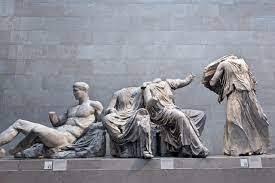
Earlier this month when I began writing this post it was going to be focused on a marauder-style looting of Scythian Gold from art museums in Melitopol and Mariupol, Ukraine by Russian forces in April of this year. But, just two weeks ago at the beginning of November there was yet another tremendous raiding at the Kherson Art Museum in Southern Ukraine. The Russians destroyed many businesses, churches, homes, and cultural sites in the raid where much of the loot was found as Museum staff and community members tried to preserve it. As aforementioned, this is not the first strike Soviet forces have made on Ukrainian Art and Cultural institutions, those who understood the cultural significance of the items tried to save them. The museum was home to hundreds of paintings dating back to the 17th Century. Shortly after the raid, Soviets withdrew from the Southern Ukrainian city of Kherson in retreat with vans full of thousands of priceless artifacts.


These stolen paintings and artifacts are a part of a larger, darker tactic to scrub Ukrainians, Belarusians, Poles, and other Eastern Europeans of their cultural heritage and independence. Art is only the tip of the iceberg unfortunately, this month's raids included the vandalism and removal of 200 year old holy remains from their resting place in one of the 250+ Orthodox and Christian churches destroyed since the war began. Not to mention the homes, businesses, technology, national monuments and written history that have been lost. This is Ethnic cleansing and it is a war crime, these pieces must be returned to Ukraine.

The Scythian gold is one of the more pressing issues of this Museum theft, though. We're talking about approximately 198 solid gold artifacts, jewelry, ornaments, weapons, armor, and sculptures dating back over 2300 years, stolen, and not because they were just stumbled upon either. Similarly to how the staff at the Kherson Museum tried to hide and preserve the artwork, the staff at the Melitopol Museum tried even harder. In a New York Times interview in April, Museum Director Leila Ibrahimova describes hiding the Scythian Gold in cardboard boxes in a cellar or basement at the first signs of Russian Militarization in Melitopol back in February. About a month later, Ibrahimova recounted being kidnapped from her home with a black bag on her head for hours of intense questioning by Russian forces. She did not give in and was released, promptly fleeing Melitopol for somewhere not under Russian control. It was another month after that when a different museum employee was put at gunpoint for the Scythian Gold, she did not lead them but they found the boxes anyway.
The next day, in Kyiv, the Mayor of Melitopol gave an enraged press announcement that Ukraine's Scythian gold was gone with the Russians and no one had its whereabouts any longer.

Scythian Gold describes a type of gold sculpture or artifact from the 7-3 Century BCE, made by Scythian or nomadic people in a geographic "band" across the Pontic-Caspian Steppe from around Romania, west through Siberia. This is one of the most sought-after collections of artwork by museums throughout history, known for its rich origins and cultural backgrounds. Scythian gold is also said to be the purest gold there is, and it has disambiguations in the context of alchemy, mythology, and religion as well. It has been reported by multiple sources, although not confirmed, that select pieces of Scythian gold that were stolen from the Melitopol Museum have hit the stolen art market online and underground for bidding. All I can say is it's a shame and I am feeling very sorry for those living in Ukraine and the generations of war, violence, natural disasters, and ethnic cleansing they have faced.
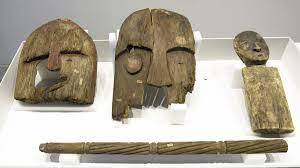
In that initial research into stolen ancient art I mentioned, I noticed that most of the articles and hot-button issues coming up were focusing on Western European countries (UK, Spain, France), stealing from prehistoric cultures around the world. It's interesting to me as a student who had weekly field trips to LOCAL (Northeastern U.S. ) art museums and saw plenty of ancient "tribal" art and cultural and religious artifacts from across the globe, that the U.S. apparently acquired all of it ethically. I digress, I just thought it was worth mentioning that a suspiciously small amount of info on stolen art in the Americas was available.
#art#art history#stolen art#stolen artifacts#ancient art#archeology#prehistoric#prehistoric art#ukraine#russia#ukraine war#looting#south ukraine#britain#british museum#fascisim#ethnic cleansing#cultural erasure#Scythian gold#middle east art#kherson#kherson retreat#kherson museum#melitopol
2 notes
·
View notes
Text
Holidays 4.1
Holidays
April Fool’s Day
April Noddy Day
Arbor Day (Tanzania)
Atheist’s Day
Boomer Bonus Day
Boy Howdy Day
Captains Regent Day (San Mario)
Capture of Brielle Remembrance (Netherlands)
Chaos Energy Day
Civil Service Day (Thailand)
Dupuytren’s Disease Awareness Day (Florida)
Edible Book Day
EOKA Day (Cyprus)
Festival of Irritating Jokes & Childish Japes
Festival of Positive Threats
Flag Day (Mauritania)
Fossil Fools Day
Gardtide (Elder Scrolls)
Ghodejatra (Katmandu Valley, Nepal)
Gowkie Day (a.k.a. Gowkin' Day; Scotland)
Greek Cypriot Day (EOKA Day; Cyprus)
Hatching Day (in “The Dragonriders of Pern”)
Hornbeam Day (French Republic)
Hunt-the-Gowk Day (Scotland)
International Birding Day (Russia)
International Bull Terrier Day
International Fun at Work Day
International Tatting Day
International Tom Hanks Day
International Waluigi Day
Intolerance Day
Investiture of the New Captains Regent (San Marino)
Islamic Republic Day (Iran)
Kalends of April (Ancient Rome)
Library Snapshot Day
Lupus Alert Day
Margaritaville Day
Myles Day
Näfelser Fahrtfest (Glarus, Switzerland)
National Atheist’s Day
National Broadcasting Day (Indonesia)
National Connor Day
National Day of Hope
National DIY Day
National Greeting Card Day
National Jump in Muddy Puddles Day
National Love Our Children Day
National Loyal Day
National Lupus Alert Day
National One Cent Day
National Tom Foolerys Day
National Tree Planting Day (Tanzania)
National Trombone Players Day
Nature Day (Iran)
Nickelodeon Day
No More Dishpan Hands Day
One Cent Day
Odisha Day (a.k.a. Orissa Day; India)
Pigasus Award Announcement Day
Poetry and the Creative Mind Day
Poisson d’Avril (France)
Reading Is Funny Day
Semana Santa ends (Nicaragua)
Social Circus Day
Sorry Charlie Day
Spaghetti Tree Day
Take Down Tobacco National Day of Action [Date Varies]
Take Your Horse to Work Day
Tangible Karma Day
US Air Force Academy Day
Užupis Day (Lithuania)
White Rabbit Day
Youth Day (Benin)
Food & Drink Celebrations
Cognac Birthday
International Day of the Barista
National Sourdough Bread Day
National Soylent Green Day
Organic Restaurant Day
Prankster Day (North Coast Brewing)
Sliced Bread Day (a.k.a. Birthday of Sliced Bread)
Soy Foods Day
1st Monday in April
National Bake Week begins [1st Monday]
National Fun Day [1st Monday]
National IEP Writing Day [1st Monday]
Sweet Potato Day [1st Monday]
Tater Day (Kentucky) [1st Monday]
Weekly Holidays beginning April 1 (1st Week)
Golden Rule Week [thru 4.7]
International Pooper Scooper Week [thru 4.7]
Laugh at Work Week [thru 4.7]
Medication Safety Week [thru 4.7]
National Bake Week (1st Monday) [thru 4.7]
National Center Registrars Week [thru 4.5]
National Egg Salad Day (Monday after Easter) [thru 4.7]
National Public Health Week [thru 4.7]
National Raw Feeding Week [thru 4.7]
National Wildlife Week [thru 4.7]
Testicular Cancer Awareness Day [thru 4.7]
Independence & Related Days
Iran (Declared a theocratic Islamic Republic; 1979)
New Year’s Days
Assyrian New Year (a.k.a. …
Akitu (ܐܟܝܬܘ)
Ha b-Nisin
Ha b-Nison
Kha b-Nisan
Resha d-Sheta
Syriac (ܪܫܐ ܕܫܢܬܐ / Head of the Year)
British Financial Year begins (UK)
Festivals Beginning April 1, 2024
Idaho Craft Beer Month (Idaho) [thru 4.30]
Kalmyk Tulip Festival (Elista, Russia) [thru 4.30]
Silverburn Carnival (Edinburgh, Scotland)
Skagit Valley Tulip Festival (Mount Vernon, Virginia) [thru 4.30]
Feast Days
All Fools Day (Pastafarian)
Anne McCaffrey (Writerism)
Benny Rabbit (Muppetism)
Catherine of Palma (Christian; Saint)
Cellach of Armagh (Christian; Saint)
The Cruelest Month Week (Shamanism)
Dan Flavin (Artology)
Day of Fornax (Goddess of Baking Bread; Ancient Rome)
Day of Hathor (Egyptian Goddess of Drunkenness; also 1.23)
Edwin Austin Abbey (Artology)
Eris Day (Church of the SubGenius; Saint)
Festival of Fortuna Virilis (Ancient Rome)
Festival of Renenutet, and the Birthday of Neper (Ancient Egyptian God of Grain)
Fortuna Virilis (Old Roman women's festival to Venus, seeking good relations with men)
Frederick Denison Maurice (Episcopal Church (USA))
Gilbert de Moray, Bishop of Caithness, Scotland (Christian; Saint)
Hippocrates (Positivist; Saint)
Hugh of Bonnevaux (Christian; Saint)
Hugh of Grenoble (Christian; Saint)
Kanamara Matsuri (Festival of the Steel Phallus; Japan)
Lazarus (Christian; Saint) [Bulgaria; Girls]
Loki's Day (Norse)
Macarius the Wonder-worker (Christian; Saint)
Mary of Egypt (Christian; Saint)
Melito of Sardis (Christian; Saint)
Milan Kundera (Writerism)
Night of the Evil Clown Day (Church of the SubGenius)
Nuno Álvares Pereira (Christian; Saint)
Samuel R. Delany (Writerism)
St. Stupid's Day (First Church of the Last Laugh; San Francisco)
Tewdrig (Christian; Saint)
Theodora (Christian; Saint)
Ticino Pasta Harvesting Day (Pastafarian)
Veneralia (Festival to Venus; Ancient Rome)
Walric, abbot of Leuconay (Christian; Saint)
William Mulready (Artology)
Christian Liturgical Holidays
Easter Monday [Monday after Easter] (a.k.a. …
Anjo Festival (Portugal)
Annandag Påsk (Sweden)
Bright Monday
Dyngus Day
Egg Nite (Roman Catholic)
Egg Races (Switzerland)
Ellis Island Family History Day
Emaishen (Luxembourg)
Family Day (South Africa)
General Debauchery Day (Pastafarian)
Hallaton Hare Pie Scramble & Bottle Kicking (Leicestershire, UK)
Memorial Day (Republic of Georgia)
Otras Lieldienas (Latvia)
Peeps Day
Pomlazk (Czechia)
Seu Harvest Parade (Curacao)
Sint Veroonmars Soldier’s Procession (Lambeek, Belgium)
Smell-the-Breezes Day (Shamm en-Nisīm; Egypt)
Veľkonočný Pondelok (Slovakia)
Watering Monday (Hungary)
Wet Easter Monday (Poland)
White House Easter Egg Roll
Lucky & Unlucky Days
Shakku (赤口 Japan) [Bad luck all day, except at noon.]
Uncyclopedia Bad to Be Born Today (because it’s April Fool’s Day.)
Premieres
Alice’s Spooky Adventure (Disney Cartoon; 1924)
Alpine Antics (Oswald the Lucky Rabbit Cartoon; 1929)
Alvin’s Solo Flight (Noveltoons Cartoon; 1961)
America the Beautiful, sung by Ray Charles (Song; 1976)
Another Roadside Attraction Tom Robbins (Novel; 1971)
Bad Luck and Trouble, 11th Jack Reacher book, by Lee Child (Novel; 2007)
Baffling Bunnies (Terrytoons Cartoon; 1956)
The Beauty Shop (Terrytoons Cartoon; 1950)
Big Bad Bobcat (Terrytoons Cartoon; 1968)
Birds of a Feather (WB LT Cartoon; 1961)
Bird Symphony (Terrytoons Cartoon; 1955)
Blaze of Glory, by Joe Jackson (Album; 1989)
The Blue Angel (Film; 1930)
The Bone Ranger (Terrytoons Cartoon; 1957)
A Boy and His Dog, by Harlan Ellison (Novella; 1969)
A Brief History of Time, by Stephen Hawking (Book; 1988)
Buddy’s Theatre (WB LT Cartoon; 1935)
Champion Chump (Terrytoons Cartoon; 1966)
Chicken Jitters (WB LT Cartoon; 1939)
A Cold Romance (Mighty Mouse Cartoon; 1949)
A Confederacy of Dunces, by John Kennedy Toole (Novel; 1980)
Conjure Wife, by Fritz Leiber (Short Story; 1943)
Daddy’s Little Darling (Terrytoons Cartoon; 1957)
Daffy Duck’s Easter Show (WB Animated TV Special; 1980)
Death: The Time of Your Life, by Neil Gaiman (Comic Mini-Series; 1996)
Dodge City (Film; 1939)
Don’t Spill the Beans (Terrytoons Cartoon; 1965)
Echo Burning, 5th Jack Reacher book, by Lee Child (Novel; 2001)
The Enlarger (Mighty Mouse Cartoon; 1970)
The Female Spectator, by Eliza Haywood (Magazine; 1744)
The Famous Ride, featuring Hector Heathcote (Terrytoons Cartoon; 1960)
The Feudin’ Hillbillies (Mighty Mouse Cartoon; 1948)
The Flamboyant Arms (Terrytoons Cartoon; 1959)
Foiling the Fox (Terrytoons Cartoon; 1950)
The Enemy, 8th Jack Reacher book, by Lee Child (Novel; 2004)
General Hospital (TV Soap Opera; 1963)
The Ghost Monster (Terrytoons Cartoon; 1970)
Gone Tomorrow, 13th Jack Reacher book, by Lee Child (Novel; 2009)
Good Deed Daly (Terrytoons Cartoon; 1955)
Goodie the Gremlin (Noveltoons Cartoon; 1961)
Hard Times, by Charles Dickens (Novel; 1854)
The Heat’s Off (Terrytoons Cartoon; 1967)
Hero For A Day (Mighty Mouse Cartoon; 1953)
Hop (Animated Film; 2011)
Hound About That (Noveltoons Cartoon; 1961)
Hounding the Hares, featuring Farmer Al Falfa (Terrytoons Cartoon; 1948)
The Hound of the Baskervilles by Arthur Conan Doyle (Novel; 1902)
Howl's Moving Castle, by Diana Wynne Jones (Novel; 1986)
The Juggler of Our Lady (Terrytoons Cartoon; 1958)
Just One More Chance (Betty Boop Cartoon; 1932)
King Rounder (Terrytoons Cartoon; 1964)
Leviathan, by Thomas Hobbes (Book; 1651)
The Little Prince, by Antoine de Saint-Exupéry (Novella; 1943)
The Lost World, by Arthur Conan Doyle (Novel; 1912)
Loyal Royalty, featuring Hashimoto (Terrytoons Cartoon; 1962)
Made for Love (TV Series; 2021)
The Mad Hermit of Chimney Butte (Animated TV Special; 1960)
Maid-Sama! (Anime Series; 2010)
The Man Who Laughs, by Victor Hugo (Novel; 1869)
The Man With the Golden Gun, by Ian Fleming (Novel; 1959) [James Bond #13]
The Meaning of Life (Film; 1983)
The Might Termite (Modern Madcaps Cartoon; 1961)
The Missing Genie (Terrytoons Cartoon; 1963)
Monkey Doodles (Noveltoons Cartoon; 1960)
Moth and the Flame (Disney Silly Symphonies Cartoon; 1938)
A Mountain Romance (Terrytoons Cartoon; 1938)
The Murders in the Rue Morgue, by Edgar Allan Poe (Short Story; 1841)
Nicholas Nickleby, by Charles Dickens (Novel; 1838)
Nobody’s Ghost, featuring Deputy Dawg (Terrytoons Cartoon; 1962)
On Her Majesty’s Secret Service, by Ian Fleming (Novel; 1959) [James Bond #11]
One Shot, 9th Jack Reacher book, by Lee Child (Novel; 2005)
The Orphan Egg (Terrytoons Cartoon; 1953)
Parade's End, by Ford Madox Ford (Novel; 1924)
Passing, by Nella Larsen (Novel; 1929)
Peanut Battle, featuring Sidney (Terrytoons Cartoon; 1962)
Personæ, by Ezra Pound (Poetry; 1909)
Person to Bunny (WB MM Cartoon; 1960)
Persuader, 7th Jack Reacher book, by Lee Child (Novel; 2003)
Pet Problems (Terrytoons Cartoon; 1954)
The Pickwick Papers, by Charles Dickens (Novel; 1836)
The Picture of Dorian Gray, by Oscar Wilde (Novel; 1891)
Play That Funky Music, by Wild Cherry (Song; 1976)
Poor Little Witch Girl (Modern Madcaps Cartoon; 1965)
Prescription For Percy, featuring Roquefort & Percy (Terrytoons Cartoon; 1954)
Running Blind, 4th Jack Reacher book, by Lee Child (Novel; 2000)
Sagebrush Sadie (Disney Oswald the Lucky Rabbit Cartoon; 1928)
Scouts to the Rescue (Terrytoons Cartoon; 1956)
Screwball Squirrel, featuring Screwy Squirrel (MGM Cartoon; 1944)
The 700 Club (Religious Propaganda Series; 1966)
Shaddup Your Face, by Joe Dolce (Song; 1981)
Sin City (Film; 2005)
Some Do Not…, by Ford Madox Ford (Novel; 1924)
The Sound of Music (Film; 1965)
Space Invaders (Video Game; 1978)
Spacewar! (Video Game; 1962)
The Stowaways (Heckle & Jeckle Cartoon; 1949)
Strange Companion, featuring Hashimoto (Terrytoons Cartoon; 1961)
The Stretcher (Mighty Mouse Cartoon; 1969)
Strife with Father (WB MM Cartoon; 1950)
The Sword of Shannara, by Terry Brooks (Novel; 1977)
Therapeutic Pink (Pink Panther Cartoon; 1977)
Time Gallops On (Terrytoons Cartoon; 1952)
Trash Program (Modern Madcaps Cartoon; 1963)
Trigger Treat (Modern Madcaps Cartoon; 1960)
The Trip (Noveltoons Cartoon; 1967)
The Tudors (TV Series; 2007)
2112, by Rush (Album; 1976)
25 O’Clock, by XTC, a.k.a. the Dukes of the Stratosphear (Album; 1985)
The War of the Worlds, by H.G. Wells (Novel; 1897)
Weather Systems, by Andrew Bird (Album; 2003)
The Winding the Willows, by Kenneth Grahame (Novel; 1908)
Without Fail, 6th Jack Reacher book, by Lee Child (Novel; 2002)
Wynonna Earp (TV Series; 2016)
Today’s Name Days
Hugo, Irene, Irina (Austria)
Anastazije, Božica, Mavro, Venancije (Croatia)
Hugo (Czech Republic)
Hugo (Denmark)
Harald, Harri, Harro, Herald (Estonia)
Peppi, Pulmu, Raita (Finland)
Hugues, Valéry (France)
Hugo, Irene, Irina (Germany)
Hugó (Hungary)
Dora, Irene, Ugo (Italy)
Dagne, Dagnis, Tautmilis, Teodora, Teofils (Latvia)
Dainora, Rimgaudas, Teodora (Lithuania)
Aron, Arve, Arvid (Norway)
Chryzant, Grażyna, Hugo, Hugon, Katarzyna, Teodora, Tolisław, Zbigniew, Zbyszko (Poland)
Maria (Romania)
Darya, Klavdia (Russia)
Hugo (Slovakia)
Hugo, Venancio (Spain)
Harald, Hervor (Sweden)
April, Arden, Argus, Diamond, Paris (USA)
Today is Also…
Day of Year: Day 92 of 2024; 274 days remaining in the year
ISO: Day 1 of week 14 of 2024
Celtic Tree Calendar: Fearn (Alder) [Day 16 of 28]
Chinese: Month 2 (Ding-Mao), Day 23 (Yi-Wei)
Chinese Year of the: Dragon 4722 (until January 29, 2025)
Hebrew: 22 Adair II 5784
Islamic: 22 Ramadan 1445
J Cal: 2 Cyan; Twosday [2 of 30]
Julian: 19 March 2024
Moon: 50%: 3rd Quarter
Positivist: 8 Archimedes (4th Month) [Euclid]
Runic Half Month: Ehwaz (Horse) [Day 7 of 15]
Season: Spring (Day 14 of 92)
Week: Last Week of March
Zodiac: Aries (Day 12 of 31)
Calendar Changes
April (Gregorian Calendar) [Month 4 of 12]
0 notes
Text
Holidays 4.1
Holidays
April Fool’s Day
April Noddy Day
Arbor Day (Tanzania)
Atheist’s Day
Boomer Bonus Day
Boy Howdy Day
Captains Regent Day (San Mario)
Capture of Brielle Remembrance (Netherlands)
Chaos Energy Day
Civil Service Day (Thailand)
Dupuytren’s Disease Awareness Day (Florida)
Edible Book Day
EOKA Day (Cyprus)
Festival of Irritating Jokes & Childish Japes
Festival of Positive Threats
Flag Day (Mauritania)
Fossil Fools Day
Gardtide (Elder Scrolls)
Ghodejatra (Katmandu Valley, Nepal)
Gowkie Day (a.k.a. Gowkin' Day; Scotland)
Greek Cypriot Day (EOKA Day; Cyprus)
Hatching Day (in “The Dragonriders of Pern”)
Hornbeam Day (French Republic)
Hunt-the-Gowk Day (Scotland)
International Birding Day (Russia)
International Bull Terrier Day
International Fun at Work Day
International Tatting Day
International Tom Hanks Day
International Waluigi Day
Intolerance Day
Investiture of the New Captains Regent (San Marino)
Islamic Republic Day (Iran)
Kalends of April (Ancient Rome)
Library Snapshot Day
Lupus Alert Day
Margaritaville Day
Myles Day
Näfelser Fahrtfest (Glarus, Switzerland)
National Atheist’s Day
National Broadcasting Day (Indonesia)
National Connor Day
National Day of Hope
National DIY Day
National Greeting Card Day
National Jump in Muddy Puddles Day
National Love Our Children Day
National Loyal Day
National Lupus Alert Day
National One Cent Day
National Tom Foolerys Day
National Tree Planting Day (Tanzania)
National Trombone Players Day
Nature Day (Iran)
Nickelodeon Day
No More Dishpan Hands Day
One Cent Day
Odisha Day (a.k.a. Orissa Day; India)
Pigasus Award Announcement Day
Poetry and the Creative Mind Day
Poisson d’Avril (France)
Reading Is Funny Day
Semana Santa ends (Nicaragua)
Social Circus Day
Sorry Charlie Day
Spaghetti Tree Day
Take Down Tobacco National Day of Action [Date Varies]
Take Your Horse to Work Day
Tangible Karma Day
US Air Force Academy Day
Užupis Day (Lithuania)
White Rabbit Day
Youth Day (Benin)
Food & Drink Celebrations
Cognac Birthday
International Day of the Barista
National Sourdough Bread Day
National Soylent Green Day
Organic Restaurant Day
Prankster Day (North Coast Brewing)
Sliced Bread Day (a.k.a. Birthday of Sliced Bread)
Soy Foods Day
1st Monday in April
National Bake Week begins [1st Monday]
National Fun Day [1st Monday]
National IEP Writing Day [1st Monday]
Sweet Potato Day [1st Monday]
Tater Day (Kentucky) [1st Monday]
Weekly Holidays beginning April 1 (1st Week)
Golden Rule Week [thru 4.7]
International Pooper Scooper Week [thru 4.7]
Laugh at Work Week [thru 4.7]
Medication Safety Week [thru 4.7]
National Bake Week (1st Monday) [thru 4.7]
National Center Registrars Week [thru 4.5]
National Egg Salad Day (Monday after Easter) [thru 4.7]
National Public Health Week [thru 4.7]
National Raw Feeding Week [thru 4.7]
National Wildlife Week [thru 4.7]
Testicular Cancer Awareness Day [thru 4.7]
Independence & Related Days
Iran (Declared a theocratic Islamic Republic; 1979)
New Year’s Days
Assyrian New Year (a.k.a. …
Akitu (ܐܟܝܬܘ)
Ha b-Nisin
Ha b-Nison
Kha b-Nisan
Resha d-Sheta
Syriac (ܪܫܐ ܕܫܢܬܐ / Head of the Year)
British Financial Year begins (UK)
Festivals Beginning April 1, 2024
Idaho Craft Beer Month (Idaho) [thru 4.30]
Kalmyk Tulip Festival (Elista, Russia) [thru 4.30]
Silverburn Carnival (Edinburgh, Scotland)
Skagit Valley Tulip Festival (Mount Vernon, Virginia) [thru 4.30]
Feast Days
All Fools Day (Pastafarian)
Anne McCaffrey (Writerism)
Benny Rabbit (Muppetism)
Catherine of Palma (Christian; Saint)
Cellach of Armagh (Christian; Saint)
The Cruelest Month Week (Shamanism)
Dan Flavin (Artology)
Day of Fornax (Goddess of Baking Bread; Ancient Rome)
Day of Hathor (Egyptian Goddess of Drunkenness; also 1.23)
Edwin Austin Abbey (Artology)
Eris Day (Church of the SubGenius; Saint)
Festival of Fortuna Virilis (Ancient Rome)
Festival of Renenutet, and the Birthday of Neper (Ancient Egyptian God of Grain)
Fortuna Virilis (Old Roman women's festival to Venus, seeking good relations with men)
Frederick Denison Maurice (Episcopal Church (USA))
Gilbert de Moray, Bishop of Caithness, Scotland (Christian; Saint)
Hippocrates (Positivist; Saint)
Hugh of Bonnevaux (Christian; Saint)
Hugh of Grenoble (Christian; Saint)
Kanamara Matsuri (Festival of the Steel Phallus; Japan)
Lazarus (Christian; Saint) [Bulgaria; Girls]
Loki's Day (Norse)
Macarius the Wonder-worker (Christian; Saint)
Mary of Egypt (Christian; Saint)
Melito of Sardis (Christian; Saint)
Milan Kundera (Writerism)
Night of the Evil Clown Day (Church of the SubGenius)
Nuno Álvares Pereira (Christian; Saint)
Samuel R. Delany (Writerism)
St. Stupid's Day (First Church of the Last Laugh; San Francisco)
Tewdrig (Christian; Saint)
Theodora (Christian; Saint)
Ticino Pasta Harvesting Day (Pastafarian)
Veneralia (Festival to Venus; Ancient Rome)
Walric, abbot of Leuconay (Christian; Saint)
William Mulready (Artology)
Christian Liturgical Holidays
Easter Monday [Monday after Easter] (a.k.a. …
Anjo Festival (Portugal)
Annandag Påsk (Sweden)
Bright Monday
Dyngus Day
Egg Nite (Roman Catholic)
Egg Races (Switzerland)
Ellis Island Family History Day
Emaishen (Luxembourg)
Family Day (South Africa)
General Debauchery Day (Pastafarian)
Hallaton Hare Pie Scramble & Bottle Kicking (Leicestershire, UK)
Memorial Day (Republic of Georgia)
Otras Lieldienas (Latvia)
Peeps Day
Pomlazk (Czechia)
Seu Harvest Parade (Curacao)
Sint Veroonmars Soldier’s Procession (Lambeek, Belgium)
Smell-the-Breezes Day (Shamm en-Nisīm; Egypt)
Veľkonočný Pondelok (Slovakia)
Watering Monday (Hungary)
Wet Easter Monday (Poland)
White House Easter Egg Roll
Lucky & Unlucky Days
Shakku (赤口 Japan) [Bad luck all day, except at noon.]
Uncyclopedia Bad to Be Born Today (because it’s April Fool’s Day.)
Premieres
Alice’s Spooky Adventure (Disney Cartoon; 1924)
Alpine Antics (Oswald the Lucky Rabbit Cartoon; 1929)
Alvin’s Solo Flight (Noveltoons Cartoon; 1961)
America the Beautiful, sung by Ray Charles (Song; 1976)
Another Roadside Attraction Tom Robbins (Novel; 1971)
Bad Luck and Trouble, 11th Jack Reacher book, by Lee Child (Novel; 2007)
Baffling Bunnies (Terrytoons Cartoon; 1956)
The Beauty Shop (Terrytoons Cartoon; 1950)
Big Bad Bobcat (Terrytoons Cartoon; 1968)
Birds of a Feather (WB LT Cartoon; 1961)
Bird Symphony (Terrytoons Cartoon; 1955)
Blaze of Glory, by Joe Jackson (Album; 1989)
The Blue Angel (Film; 1930)
The Bone Ranger (Terrytoons Cartoon; 1957)
A Boy and His Dog, by Harlan Ellison (Novella; 1969)
A Brief History of Time, by Stephen Hawking (Book; 1988)
Buddy’s Theatre (WB LT Cartoon; 1935)
Champion Chump (Terrytoons Cartoon; 1966)
Chicken Jitters (WB LT Cartoon; 1939)
A Cold Romance (Mighty Mouse Cartoon; 1949)
A Confederacy of Dunces, by John Kennedy Toole (Novel; 1980)
Conjure Wife, by Fritz Leiber (Short Story; 1943)
Daddy’s Little Darling (Terrytoons Cartoon; 1957)
Daffy Duck’s Easter Show (WB Animated TV Special; 1980)
Death: The Time of Your Life, by Neil Gaiman (Comic Mini-Series; 1996)
Dodge City (Film; 1939)
Don’t Spill the Beans (Terrytoons Cartoon; 1965)
Echo Burning, 5th Jack Reacher book, by Lee Child (Novel; 2001)
The Enlarger (Mighty Mouse Cartoon; 1970)
The Female Spectator, by Eliza Haywood (Magazine; 1744)
The Famous Ride, featuring Hector Heathcote (Terrytoons Cartoon; 1960)
The Feudin’ Hillbillies (Mighty Mouse Cartoon; 1948)
The Flamboyant Arms (Terrytoons Cartoon; 1959)
Foiling the Fox (Terrytoons Cartoon; 1950)
The Enemy, 8th Jack Reacher book, by Lee Child (Novel; 2004)
General Hospital (TV Soap Opera; 1963)
The Ghost Monster (Terrytoons Cartoon; 1970)
Gone Tomorrow, 13th Jack Reacher book, by Lee Child (Novel; 2009)
Good Deed Daly (Terrytoons Cartoon; 1955)
Goodie the Gremlin (Noveltoons Cartoon; 1961)
Hard Times, by Charles Dickens (Novel; 1854)
The Heat’s Off (Terrytoons Cartoon; 1967)
Hero For A Day (Mighty Mouse Cartoon; 1953)
Hop (Animated Film; 2011)
Hound About That (Noveltoons Cartoon; 1961)
Hounding the Hares, featuring Farmer Al Falfa (Terrytoons Cartoon; 1948)
The Hound of the Baskervilles by Arthur Conan Doyle (Novel; 1902)
Howl's Moving Castle, by Diana Wynne Jones (Novel; 1986)
The Juggler of Our Lady (Terrytoons Cartoon; 1958)
Just One More Chance (Betty Boop Cartoon; 1932)
King Rounder (Terrytoons Cartoon; 1964)
Leviathan, by Thomas Hobbes (Book; 1651)
The Little Prince, by Antoine de Saint-Exupéry (Novella; 1943)
The Lost World, by Arthur Conan Doyle (Novel; 1912)
Loyal Royalty, featuring Hashimoto (Terrytoons Cartoon; 1962)
Made for Love (TV Series; 2021)
The Mad Hermit of Chimney Butte (Animated TV Special; 1960)
Maid-Sama! (Anime Series; 2010)
The Man Who Laughs, by Victor Hugo (Novel; 1869)
The Man With the Golden Gun, by Ian Fleming (Novel; 1959) [James Bond #13]
The Meaning of Life (Film; 1983)
The Might Termite (Modern Madcaps Cartoon; 1961)
The Missing Genie (Terrytoons Cartoon; 1963)
Monkey Doodles (Noveltoons Cartoon; 1960)
Moth and the Flame (Disney Silly Symphonies Cartoon; 1938)
A Mountain Romance (Terrytoons Cartoon; 1938)
The Murders in the Rue Morgue, by Edgar Allan Poe (Short Story; 1841)
Nicholas Nickleby, by Charles Dickens (Novel; 1838)
Nobody’s Ghost, featuring Deputy Dawg (Terrytoons Cartoon; 1962)
On Her Majesty’s Secret Service, by Ian Fleming (Novel; 1959) [James Bond #11]
One Shot, 9th Jack Reacher book, by Lee Child (Novel; 2005)
The Orphan Egg (Terrytoons Cartoon; 1953)
Parade's End, by Ford Madox Ford (Novel; 1924)
Passing, by Nella Larsen (Novel; 1929)
Peanut Battle, featuring Sidney (Terrytoons Cartoon; 1962)
Personæ, by Ezra Pound (Poetry; 1909)
Person to Bunny (WB MM Cartoon; 1960)
Persuader, 7th Jack Reacher book, by Lee Child (Novel; 2003)
Pet Problems (Terrytoons Cartoon; 1954)
The Pickwick Papers, by Charles Dickens (Novel; 1836)
The Picture of Dorian Gray, by Oscar Wilde (Novel; 1891)
Play That Funky Music, by Wild Cherry (Song; 1976)
Poor Little Witch Girl (Modern Madcaps Cartoon; 1965)
Prescription For Percy, featuring Roquefort & Percy (Terrytoons Cartoon; 1954)
Running Blind, 4th Jack Reacher book, by Lee Child (Novel; 2000)
Sagebrush Sadie (Disney Oswald the Lucky Rabbit Cartoon; 1928)
Scouts to the Rescue (Terrytoons Cartoon; 1956)
Screwball Squirrel, featuring Screwy Squirrel (MGM Cartoon; 1944)
The 700 Club (Religious Propaganda Series; 1966)
Shaddup Your Face, by Joe Dolce (Song; 1981)
Sin City (Film; 2005)
Some Do Not…, by Ford Madox Ford (Novel; 1924)
The Sound of Music (Film; 1965)
Space Invaders (Video Game; 1978)
Spacewar! (Video Game; 1962)
The Stowaways (Heckle & Jeckle Cartoon; 1949)
Strange Companion, featuring Hashimoto (Terrytoons Cartoon; 1961)
The Stretcher (Mighty Mouse Cartoon; 1969)
Strife with Father (WB MM Cartoon; 1950)
The Sword of Shannara, by Terry Brooks (Novel; 1977)
Therapeutic Pink (Pink Panther Cartoon; 1977)
Time Gallops On (Terrytoons Cartoon; 1952)
Trash Program (Modern Madcaps Cartoon; 1963)
Trigger Treat (Modern Madcaps Cartoon; 1960)
The Trip (Noveltoons Cartoon; 1967)
The Tudors (TV Series; 2007)
2112, by Rush (Album; 1976)
25 O’Clock, by XTC, a.k.a. the Dukes of the Stratosphear (Album; 1985)
The War of the Worlds, by H.G. Wells (Novel; 1897)
Weather Systems, by Andrew Bird (Album; 2003)
The Winding the Willows, by Kenneth Grahame (Novel; 1908)
Without Fail, 6th Jack Reacher book, by Lee Child (Novel; 2002)
Wynonna Earp (TV Series; 2016)
Today’s Name Days
Hugo, Irene, Irina (Austria)
Anastazije, Božica, Mavro, Venancije (Croatia)
Hugo (Czech Republic)
Hugo (Denmark)
Harald, Harri, Harro, Herald (Estonia)
Peppi, Pulmu, Raita (Finland)
Hugues, Valéry (France)
Hugo, Irene, Irina (Germany)
Hugó (Hungary)
Dora, Irene, Ugo (Italy)
Dagne, Dagnis, Tautmilis, Teodora, Teofils (Latvia)
Dainora, Rimgaudas, Teodora (Lithuania)
Aron, Arve, Arvid (Norway)
Chryzant, Grażyna, Hugo, Hugon, Katarzyna, Teodora, Tolisław, Zbigniew, Zbyszko (Poland)
Maria (Romania)
Darya, Klavdia (Russia)
Hugo (Slovakia)
Hugo, Venancio (Spain)
Harald, Hervor (Sweden)
April, Arden, Argus, Diamond, Paris (USA)
Today is Also…
Day of Year: Day 92 of 2024; 274 days remaining in the year
ISO: Day 1 of week 14 of 2024
Celtic Tree Calendar: Fearn (Alder) [Day 16 of 28]
Chinese: Month 2 (Ding-Mao), Day 23 (Yi-Wei)
Chinese Year of the: Dragon 4722 (until January 29, 2025)
Hebrew: 22 Adair II 5784
Islamic: 22 Ramadan 1445
J Cal: 2 Cyan; Twosday [2 of 30]
Julian: 19 March 2024
Moon: 50%: 3rd Quarter
Positivist: 8 Archimedes (4th Month) [Euclid]
Runic Half Month: Ehwaz (Horse) [Day 7 of 15]
Season: Spring (Day 14 of 92)
Week: Last Week of March
Zodiac: Aries (Day 12 of 31)
Calendar Changes
April (Gregorian Calendar) [Month 4 of 12]
0 notes
Link
0 notes